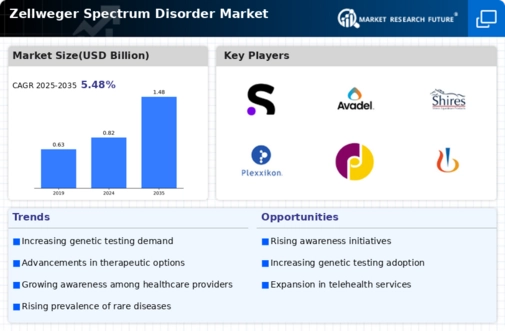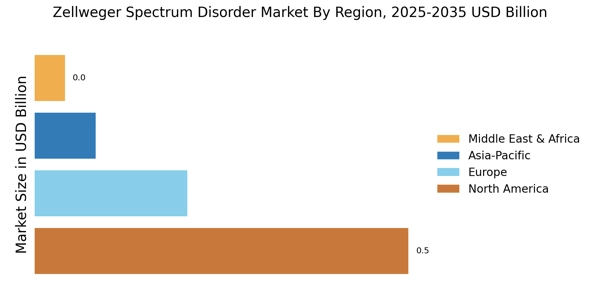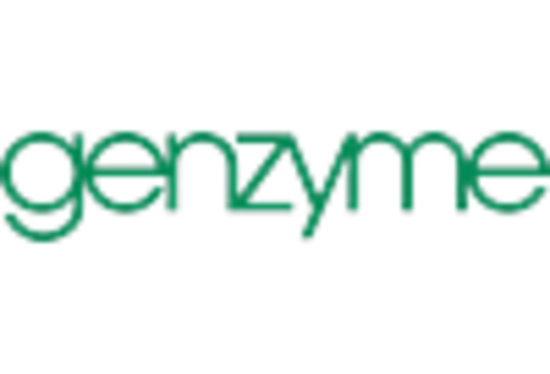Rising Support from Advocacy Groups
Advocacy groups play a crucial role in shaping the Zellweger Spectrum Disorder Market by raising awareness and providing support for affected individuals and families. These organizations often engage in fundraising efforts to support research initiatives and promote education about ZSD. Their activities help to create a more informed public, which can lead to increased demand for diagnostic and therapeutic options. Furthermore, advocacy groups often collaborate with healthcare professionals and researchers to facilitate clinical trials and improve access to treatments. This collaborative approach not only enhances the visibility of ZSD but also drives innovation within the market. As advocacy efforts continue to grow, the Zellweger Spectrum Disorder Market is likely to experience increased momentum and support.
Increased Focus on Personalized Medicine
The shift towards personalized medicine is emerging as a pivotal driver in the Zellweger Spectrum Disorder Market. Tailoring treatment approaches based on individual genetic profiles is gaining traction, particularly for complex disorders like ZSD. This paradigm shift is supported by advancements in genomics and biotechnology, which enable healthcare providers to customize therapies that align with the specific needs of patients. As personalized medicine becomes more prevalent, the demand for targeted therapies and individualized treatment plans is expected to rise. This trend not only enhances patient outcomes but also fosters a more patient-centric approach within the Zellweger Spectrum Disorder Market. The potential for personalized therapies to improve efficacy and reduce adverse effects may further stimulate market growth.
Growing Investment in Rare Disease Research
The Zellweger Spectrum Disorder Market is experiencing a surge in investment aimed at rare disease research. Governments and private organizations are increasingly recognizing the need for targeted therapies for rare genetic disorders like ZSD. Funding initiatives and grants are being allocated to support research projects focused on understanding the underlying mechanisms of ZSD and developing novel treatment options. This influx of capital is likely to accelerate the pace of clinical trials and the introduction of innovative therapies into the market. Additionally, collaborations between pharmaceutical companies and research institutions are becoming more common, further enhancing the research landscape. As a result, the Zellweger Spectrum Disorder Market stands to benefit from a more robust pipeline of potential therapies.
Technological Advancements in Diagnostic Tools
Technological innovations in diagnostic tools are significantly influencing the Zellweger Spectrum Disorder Market. Enhanced imaging techniques and genetic testing methods have improved the accuracy and speed of ZSD diagnosis. For instance, next-generation sequencing (NGS) has emerged as a powerful tool for identifying genetic mutations associated with ZSD, allowing for earlier and more precise diagnoses. This advancement not only aids in timely intervention but also fosters a better understanding of the disorder's pathophysiology. As diagnostic capabilities improve, healthcare providers are likely to increase their focus on ZSD, thereby driving demand for related treatments and services within the Zellweger Spectrum Disorder Market. The integration of artificial intelligence in diagnostic processes may further streamline patient management and enhance outcomes.
Increasing Prevalence of Zellweger Spectrum Disorder
The rising incidence of Zellweger Spectrum Disorder Market (ZSD) is a notable driver in the Zellweger Spectrum Disorder Market. Recent estimates suggest that ZSD affects approximately 1 in 50,000 to 1 in 100,000 live births. This increasing prevalence necessitates enhanced diagnostic and therapeutic options, thereby propelling market growth. As healthcare providers become more aware of the disorder, the demand for specialized treatments and interventions is likely to rise. Furthermore, the growing number of patients diagnosed with ZSD may lead to increased funding for research and development, ultimately benefiting the Zellweger Spectrum Disorder Market. The need for effective management strategies and support systems for affected families also contributes to the market's expansion.


















Leave a Comment